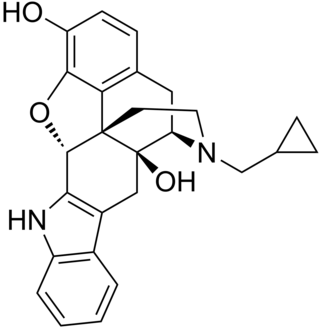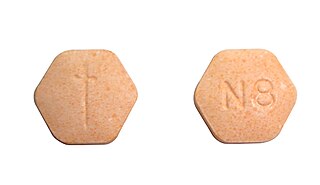Related Research Articles

Asperger syndrome (AS), also known as Asperger's syndrome, formerly described a neurodevelopmental disorder characterized by significant difficulties in social interaction and nonverbal communication combined with restricted and repetitive patterns of behavior and interests. The syndrome has been merged with other disorders into autism spectrum disorder (ASD) and is no longer considered a stand-alone diagnosis. It was considered to differ from other diagnoses that were merged into ASD by relatively unimpaired spoken language and intelligence.

Coeliac disease or celiac disease is a long-term autoimmune disorder, primarily affecting the small intestine, where individuals develop intolerance to gluten, present in foods such as wheat, rye and barley. Classic symptoms include gastrointestinal problems such as chronic diarrhoea, abdominal distention, malabsorption, loss of appetite, and among children failure to grow normally. Non-classic symptoms are more common, especially in people older than two years. There may be mild or absent gastrointestinal symptoms, a wide number of symptoms involving any part of the body, or no obvious symptoms. Coeliac disease was first described in childhood; however, it may develop at any age. It is associated with other autoimmune diseases, such as Type 1 diabetes mellitus and Hashimoto's thyroiditis, among others.

Casein is a family of related phosphoproteins that are commonly found in mammalian milk, comprising about 80% of the proteins in cow's milk and between 20% and 60% of the proteins in human milk. Sheep and cow milk have a higher casein content than other types of milk with human milk having a particularly low casein content.
A gluten-free casein-free diet, also known as a gluten-free dairy-free diet, is a diet that does not include gluten, and casein. Despite an absence of scientific evidence, there have been advocates for the use of this diet as a treatment for autism and related conditions.

Casomorphin is an opioid peptide derived from the digestion of the milk protein casein.

Naltrexone, sold under the brand name Revia among others, is a medication primarily used to manage alcohol use or opioid use disorder by reducing cravings and feelings of euphoria associated with substance use disorder. It has also been found effective in the treatment of other addictions and may be used for them off-label. An opioid-dependent person should not receive naltrexone before detoxification. It is taken by mouth or by injection into a muscle. Effects begin within 30 minutes, though a decreased desire for opioids may take a few weeks to occur. Side effects may include trouble sleeping, anxiety, nausea, and headaches. In those still on opioids, opioid withdrawal may occur. Use is not recommended in people with liver failure. It is unclear if use is safe during pregnancy. Naltrexone is an opioid antagonist and works by blocking the effects of opioids, including both opioid drugs as well as opioids naturally produced in the brain.
Gluten exorphins are a group of opioid peptides formed during the digestion of the gluten protein. These peptides work as external regulators for gastrointestinal movement and hormonal release. The breakdown of gliadin, a polymer of wheat proteins, creates amino acids that stop the gluten epitopes from entering the immune system to activate inflammatory reactions. During this process, gluten does not fully break down, thus increasing the presence of gluten exorphins. Because of this, researchers think this is what might lead to various diseases.

Gliadorphin is an opioid peptide that is formed during digestion of the gliadin component of the gluten protein. It is usually broken down into amino acids by digestion enzymes. It has been hypothesized that children with autism have abnormal leakage from the gut of this compound. This is partly the basis for the gluten-free, casein-free diet. Abnormally high levels of gliadorphin have been found in the urine of autistic children via mass spectrometry testing.

Opioid peptides or opiate peptides are peptides that bind to opioid receptors in the brain; opiates and opioids mimic the effect of these peptides. Such peptides may be produced by the body itself, for example endorphins. The effects of these peptides vary, but they all resemble those of opiates. Brain opioid peptide systems are known to play an important role in motivation, emotion, attachment behaviour, the response to stress and pain, control of food intake, and the rewarding effects of alcohol and nicotine.

The causes of autism are environmental or genetic factors that predispose an individual to develop autism, also known as autism spectrum disorder (ASD). Many causes of autism have been proposed, but understanding of the theory of causation of autism is incomplete. Attempts have been made to incorporate the known genetic and environmental causes into a comprehensive causative framework. ASD is a neurodevelopmental disorder marked by impairments in communicative ability and social interaction and restricted/repetitive behaviors, interests, or activities not suitable for the individual's developmental stage. The severity of symptoms and functional impairment vary between individuals.

Autism therapies include a wide variety of therapies that help people with autism, or their families. Such methods of therapy seek to aid autistic people in dealing with difficulties and increase their functional independence.

Naltrindole is a highly potent, highly selective delta opioid receptor antagonist used in biomedical research. In May 2012 a paper was published in Nature with the structure of naltrindole in complex with the mouse δ-opioid G-protein coupled receptor, solved by X-ray crystallography.

Autism, formally called autism spectrum disorder (ASD) or autism spectrum condition (ASC), is a neurodevelopmental disorder marked by impaired social communication, and the presence of restricted and repetitive patterns of behavior. Specifically, these symptoms encompass difficulties with social interaction, verbal and nonverbal communication, along with perseverative interests, stereotyped body movements, rigid routines, and hyper- or hyporeactivity to sensory input. Autism is clinically regarded as a spectrum disorder, meaning that it can manifest very differently in each person. For example, some are nonspeaking, while others have proficient spoken language. Because of this, there is wide variation in the support needs of people across the autism spectrum.
Exorphins are exogenous opioid peptides, distinguished from endorphins, or endogenous opioid peptides.
Martha Herbert is an American physician and assistant professor of neurology at Harvard Medical School and pediatric neurologist at Massachusetts General Hospital. Herbert is also director of the TRANSCEND program at the Athinoula A. Martinos Center for Biomedical Imaging.
Paul Shattock is a British autism researcher and scientific consultant to the charity Education and Services for People with Autism, of which he is also the founder. He was formerly the director of the Autism Research Unit at the University of Sunderland. He is well known for his disputed research into dietary therapy and autism, having claimed that autistic children may have a "leaky gut" which allows certain peptides to enter the bloodstream, and claimed that they excrete unusually high levels thereof. As a result of this speculation, he has promoted the use of a gluten-free, casein-free diet to ameliorate the symptoms of autism, a theory he developed along with Kalle Reichelt. In addition, he has claimed that a protein found in milk may play a role in the etiology of autism. He is also the former president of the World Autism Organization.
Timothy M. Buie is a pediatric gastroenterologist at Boston Children’s Hospital. Buie joined Harvard Medical School in 1998 after previously practicing at Pediatric Gastroenterology Associates for eight years. He was also the director of Gastrointestinal and Nutritional Services at MGH's Lurie Center for Autism. He is well known for his research pertaining to the possible connection between autism and gastrointestinal disorders, and has told the Interagency Autism Coordinating Committee that over half of autistic children experience gastrointestinal symptoms, whereas he stated that this was the case for "between 50 and 70%" of children with autism in an interview with ABC News. He has also said that a subset of autistic children may benefit from gluten-free, casein-free diets, and that more research is needed into this area. Buie was honored as "Professional of the Year" by the Autism Society of America in 2009.

6β-Naltrexol, or 6β-hydroxynaltrexone, is a peripherally-selective opioid receptor antagonist related to naltrexone. It is a major active metabolite of naltrexone formed by hepatic dihydrodiol dehydrogenase enzymes. With naltrexone therapy, 6β-naltrexol is present at approximately 10- to 30-fold higher concentrations than naltrexone at steady state due to extensive first-pass metabolism of naltrexone into 6β-naltrexol. In addition to being an active metabolite of naltrexone, 6β-naltrexol was itself studied for the treatment of opioid-induced constipation. It was found to be effective and well-tolerated, and did not precipitate opioid withdrawal symptoms or interfere with opioid pain relief, but development was not further pursued.
Sex and gender differences in autism exist regarding prevalence, presentation, and diagnosis.

Opioid withdrawal is a set of symptoms arising from the sudden withdrawal or reduction of opioids where previous usage has been heavy and prolonged. Signs and symptoms of withdrawal can include drug craving, anxiety, restless legs, nausea, vomiting, diarrhea, sweating, and an increased heart rate. Opioid use triggers a rapid adaptation in cellular signalling pathways that means, when rapidly withdrawn, there can be adverse physiological effects. All opioids, both recreational drugs and medications, when reduced or stopped, can lead to opioid withdrawal symptoms. When withdrawal symptoms are due to recreational opioid use, the term opioid use disorder is used, whereas when due to prescribed medications, the term prescription opioid use disorder is used. Opioid withdrawal can be helped by the use of opioid replacement therapy, and symptoms may be relieved by the use of medications including lofexidine and clonidine.
References
- ↑ Millward, C.; Ferriter, M.; Calver, S. J.; Connell-Jones, G. G. (2008). Ferriter, Michael (ed.). "Gluten- and casein-free diets for autistic spectrum disorder". The Cochrane Database of Systematic Reviews (2): CD003498. doi:10.1002/14651858.CD003498.pub3. PMC 4164915 . PMID 18425890.
- ↑ Special diets and autism
- ↑ Panksepp, J. (1979). "A neurochemical theory of autism". Trends in Neurosciences. 2: 174–177. doi:10.1016/0166-2236(79)90071-7. S2CID 54373822.
- ↑ Reichelt, K. L.; Hole, K.; Hamberger, A.; et al. (1981). "Biologically active peptide-containing fractions in schizophrenia and childhood autism". Advances in Biochemical Psychopharmacology. 28: 627–643. PMID 7010949.
- ↑ Probable etiology and possible treatment of childhood autism
- ↑ Wakefield, A. J.; Murch, S. H.; Anthony, A.; Linnell, J.; Casson, D. M.; Malik, M.; Berelowitz, M.; Dhillon, A. P.; Thomson, M. A.; Harvey, P.; Valentine, A.; Davies, S. E.; Walker-Smith, J. A. (1998). "RETRACTED: Ileal-lymphoid-nodular hyperplasia, non-specific colitis, and pervasive developmental disorder in children". The Lancet. 351 (9103): 637–641. doi:10.1016/S0140-6736(97)11096-0. PMID 9500320. S2CID 439791.
- ↑ Knivsberg, A. M.; Reichelt, K. L.; n⊘Dland, M.; h⊘Ien, T. (1995). "Autistic Syndromes and Diet: A follow-up study". Scandinavian Journal of Educational Research. 39 (3): 223–236. doi:10.1080/0031383950390304.
- ↑ Lensing, P.; Schimke, H.; Klimesch, W.; Pap, V.; Szemes, G.; Klingler, D.; Panksepp, J. (1995). "Clinical case report: Opiate antagonist and event-related desynchronization in 2 autistic boys". Neuropsychobiology. 31 (1): 16–23. doi:10.1159/000119167. PMID 7708177.
- ↑ Sahley, T. L.; Panksepp, J. (1987). "Brain opioids and autism: An updated analysis of possible linkages". Journal of Autism and Developmental Disorders. 17 (2): 201–216. doi:10.1007/BF01495056. PMID 3038836. S2CID 46566945.
- ↑ Bouvard, M. P.; Leboyer, M.; Launay, J. M.; Recasens, C.; Plumet, M. H.; Waller-Perotte, D.; Tabuteau, F.; Bondoux, D.; Dugas, M.; Lensing, P.; Panksepp, J. (1995). "Low-dose naltrexone effects on plasma chemistries and clinical symptoms in autism: A double-blind, placebo-controlled study". Psychiatry Research. 58 (3): 191–201. doi:10.1016/0165-1781(95)02601-R. PMID 8570775. S2CID 26253683.
- ↑ "Social Dysfunction in Autism and Connection with Endogenous Opiads". www.macalester.edu. Archived from the original on 2003-09-24.
- ↑ Gillberg, C. (1995). "Endogenous opioids and opiate antagonists in autism: Brief review of empirical findings and implications for clinicians". Developmental Medicine & Child Neurology. 37 (3): 239–245. doi:10.1111/j.1469-8749.1995.tb11998.x. PMID 7890130. S2CID 28604551.
- ↑ Hunter, L. C.; O'Hare, A.; Herron, W. J.; Fisher, L. A.; Jones, G. E. (2007). "Opioid peptides and dipeptidyl peptidase in autism". Developmental Medicine & Child Neurology. 45 (2): 121–8. doi:10.1111/j.1469-8749.2003.tb00915.x. PMID 12578238. S2CID 38949901.
- ↑ Cass, H.; Gringras, P.; March, J.; McKendrick, I.; O'Hare, A. E.; Owen, L.; Pollin, C. (2008). "Absence of urinary opioid peptides in children with autism". Archives of Disease in Childhood. 93 (9): 745–750. doi: 10.1136/adc.2006.114389 . PMID 18337276.
- ↑ Mulloy, Austin; Lang, Russell; O’Reilly, Mark; Sigafoos, Jeff; Lancioni, Giulio; Rispoli, Mandy (July 2010). "Gluten-free and casein-free diets in the treatment of autism spectrum disorders: A systematic review". Research in Autism Spectrum Disorders. 4 (3): 328–339. doi:10.1016/j.rasd.2009.10.008.
- ↑ Roy, A; Roy, M; Deb, S; Unwin, G; Roy, A (2014). "Are opioid antagonists effective in attenuating the core symptoms of autism spectrum conditions in children: A systematic review". Journal of Intellectual Disability Research. 59 (4): 293–306. doi:10.1111/jir.12122. PMID 24589346. S2CID 11896817.